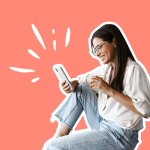Remember the shampoo ad from years ago…. “She told 2 friends, and they told 2 friends, and they told 2 friends, and so on and so on and so on….?” In today’s social media language, this is more like, “She shared with 500 friends and they shared with 500 friends, and so on, and so on, and so on….”
If you are the parent of a “tween,” the thought that your child could potentially be sharing his/her story with the world via social networking sites is a scary thing. That’s why it is so important to set some ground rules for your tweens when it comes to their use of social media to help them understand the kind of activity that is off-limits for their protection.
But where should you start?
It may be difficult for many parents to enforce rules when their “tech savvy tween” is far more experienced than they are on social networks. As we all know, experience doesn’t necessarily equal maturity and good decision-making in a young mind.
Here are 2 quick, but effective guidelines that will give you a start to keeping your child safe on social networking sites.
Guideline #1: Tweens should only be permitted to participate on social networks that are COPPA compliant. COPPA is an acronym for the Federal Trade Commission’s required “Children’s Online Privacy Protection Act,” which requires that users under 13 are secured and monitored by a parent account. In other words, your tween should only be able to create an account on a network with parent approval and input as required by the site.
Guideline #2: You should also require your tweens use whatever privacy settings are available on the networks they log into. Do you know the type of content your child is posting, such as photos or videos? More importantly, has your child been tagged in a photo or video that someone else has posted? If this is the case, then that means an exponentially higher number of people may have the ability to access your child’s profile and information through that photo tag (remember the aforementioned commercial, “She shared with 500 friends and they shared with 500 friends, etc…”). By reviewing and adjusting the available privacy settings on the social networks your tween participates on, you are certainly taking some steps to protect activity and information.
The bottom line, when it comes to your child’s safety and privacy on social networks, there are many things to consider and it should not be left to chance. Are you stumped on privacy settings? Do you feel like you have a handle on some of your tween’s social media activity but not on all of it? We’d love to hear YOUR questions!
For information on digital citizenship, online bullying prevention, and safe social media use for tweens, be sure to check out our revolutionary online program for parents of tweens called, Saving Face™!
Thanks for reading!
This blog contributed to by Hay There Social Media team member Sheri Watkins.








